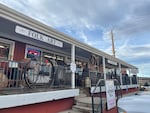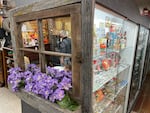
Exterior view of the Farmer's Co-op Antique Mall in Redmond, Ore., on Dec. 18, 2020.
Emily Cureton Cook / OPB
Editor’s note: This story contains descriptions of racist memorabilia and anti-Semitic items, some of which contain racial epithets.
Things with past lives filled every corner of the Farmers Co-op Antique Mall in Redmond. Decoy ducks nested among the rusty typewriters, musty clothes, and toys made for children who grew old long ago. The floorboards creaked as customers wandered through the maze of booths on a recent day. At first glance, one glass display case looked a lot like dozens of others: well-lit and full of knick knacks. But, something inside made 15-year-old Lily Gallentine do a double take.
“Am I seeing that right?” she remembered thinking. Then, she said, her heart began to race.
“There were a bunch of different Nazi pins. There was a poster in the background, saying ‘coon’ and ‘monkey.’ There was a black doll in the background, which I thought was weird, that it was right there and not just with like, normal dolls,” Lily said.
Before now, this store had been a refuge for the 10th grader from Redmond: “Just to get out. We go to a few antique stores, poke around, and have some fun.” She said she likes to “see the stories behind certain things.”
On the day described, Lily had been hunting for toy cars to give to her dad, who collects them. When she found the case of swastikas, the price tags were $36 each, the pins neatly lined up under an ashtray with a Blackface caricature from the now-defunct “Coon Chicken Inn,” a restaurant chain until 1957. More of the chain’s racist merchandise was on sale, like a poster marked down to $18.
Mass protests since the spring of 2020 have brought attention to racism in systems, actions and beliefs. But as Lily discovered, hate can also take the shape of material objects. Lily’s mom, Andrea Utz, joined her daughter in front of the case that day. Utz said she felt “stunned, then disappointed, and then just like, ‘Ugh, here we go, again.’”
“Again” because last summer at least one person targeted the family with a racist action in their own Redmond neighborhood.
“We put up a Black Lives Matter sign in our yard, and a day or two later it was stolen. It was gone,” Lily said, describing how they responded by planting a new sign, this one a little closer to the house. “And a day later, we were just sitting at the dinner table, and the doorbell rang.”
Utz got up and answered. But, no one was there. On the porch, someone had left a watermelon — the letters BLM carved into it with a permanent marker. The rind looked chiseled, because the letters had been rewritten so many times, and with such force. The newly-placed yard sign was gone.
“The thought of not knowing what their intention was, or who it was, that was what was most frightening and unsettling,” Lily said.
Watermelons have long been subverted as symbols of racism against Black Americans. The Deschutes County District Attorney’s Office assigned an investigator to look into the incident as a possible hate crime. But neither prosecutors, nor Redmond police turned up any leads, according to District Attorney John Hummel.
Months later, Utz, who is white, was still shaken: “I’m not going to let my daughter, who is a person of color, walk around alone at night here, even with her friends.”
The population of Redmond is 90% white — a demographic rooted in Oregon’s legacy of systemic racism. The Oregon Constitution originally forbade Black settlers from moving to the state. Other laws prohibited Black people from owning property and making contracts. These exclusion laws were repealed almost a century ago, but more racist language in Oregon’s founding document wasn’t removed by voters until 2002.
At the Old Farmer Co-op antique mall in Redmond, the symbols of white supremacy almost blend in.

At the Redmond Farmer's Co-op Antique Mall on Dec. 18, 2020, the case on the right offers for sale a number of Nazi symbols and caricatures promoting racist stereotypes among other kinds of memorabilia.
Emily Cureton Cook / OPB
“Well, yeah. That’s memorabilia that people buy,” store owner Ike Abbas said when asked about the display. “I’ve been doing it for 37 years, and people enjoy it. Blacks even buy it. We got one gal in there that is Black and she sells a lot of stuff.”
When pressed about the juxtaposition of swastikas with Black Americana and racist caricatures, he defended the vendor’s right to sell whatever they want in a space they have rented from Abbas for $55 per month.
Vendors can sell what they please, the antiques dealer said, as long as it’s legal, Abbas said. “And we don’t sell guns, just because people break in to get guns.”
National conversations spur a fresh look at old collections
Selling Nazi and racist memorabilia isn’t against the law in the U.S., but with national conversations about the country’s racist history ongoing, the purpose of such sales is in question — particularly when the items are jumbled together with no historical context.
“The only audience that is going to be into racist, Black Americana, as well as Nazi memorabilia, would presumably be a racist audience,” said Mark Pitcavage, who monitors extremism for the Anti-Defamation League, a nonprofit that documents anti-Semitism and other types of bigotry.
Pitcavage said that there can be nuances to why people collect some offensive items. He said context is key — such as if something is in a museum or for sale — and that the motivations of the collector are important to consider.

On tours of the Jim Crow Museum Ferris State University in Michigan, like this one led by David Pilgrim on Aug. 8, 2018, visitors are often asked to describe what they see in the objects, and then to try and explain how it is they came to see things a certain way.
Courtesy of the Jim Crow Museum
David Pilgrim remembers being about 12 years old when he got his first racist artifact at a flea market. He thinks it was a so-called “mammy” salt shaker, which he bought, then destroyed in front of the vendor, “as an act of defiance.”
“Growing up a multi-racial, Black identified kid in the Deep South in the last days of Jim Crow, I thought about race a lot,” Pilgrim said.
Over the decades, he kept collecting racist objects, things “that you would find in someone’s home, in their kitchen, in their restroom, in their living room.”
Pilgrim eventually became a sociologist and a professor, and started using his collection as educational tools. He said he would often start with a simple question.
“When you look at this, what is it you see?” he said. “And it will always amaze me how people reared in the same way, often the same hometowns, will have such divergence in the way they look at an object, especially one dealing with race.”

David Pilgrim speaks to a high school class at the Jim Crow Museum of Racist Memorabilia in Michigan on Jan. 21, 2015. Pilgrim said the museum's mandate is to "create an environment where people can not just talk about race, race relations, and racism in intelligent ways, but that we start from an accurate understanding of the past."
Emily Cureton Cook
Pilgrim founded the Jim Crow Museum of Racist Memorabilia at Ferris State University in Michigan. He refers to the museum’s holdings, which include more than the 10,000 items on display, as propaganda, “because when we show these racist depictions in cookie jars, in toys, in games, in everyday objects, it’s a very sneaky way to spread those ideas.”
These depictions often stereotype Black people as subservient, foolish, evil, or less than human. And they’re still for sale.
“Those Jim Crow ideas, those Jim Crow representations, those Jim Crow lies — morphed into, and continue to exist in the present,” Pilgrim said.
Among the newer items in the museum’s collection, President Barack Obama is portrayed as a monkey, a cannibal and a sexual predator.
Learning there’s a market for hateful objects from both the past and the present reminded Lily, the Redmond teen, why she became an activist during the racial justice demonstrations of 2020.
“I just try to remember like, ‘Hey, this is the reason why I’m going to protests and I’m educating myself, and educating others, and raising my voice,’” Lily said.
Her family has put a new Black Lives Matter sign in their front yard, a visible marker that they haven’t been forced into silence. But her courage comes with a cost, too. In addition to the sign, the family installed a security camera.
